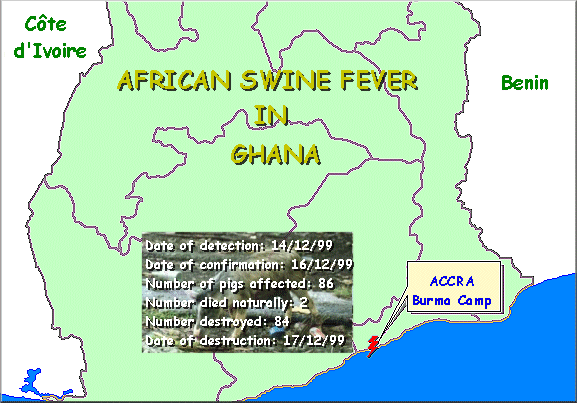


AFRICAN SWINE FEVER
The epidemiological situation appeared to be stable, with no reports of further
outbreaks since October 1999. However, on 15 December a suspicion was reported
from Burma Camp, a military camp within an infected district of Greater Accra.
Two pigs were presented to the laboratory for necropsy and tests carried
out with FITC reagents and microscope suggested that the samples were positive
for ASF (Dr G. Opoku-Pare, personal communication). For confirmatory diagnosis,
the samples were sent to the Exotic Diseases Division of ARC-Onderstepoort
Veterinary Institute for confirmation by PCR and bone marrow culture.

There were no reports of infection from previously unaffected areas.
Following the outbreak of ASF in Ghana, a TCP project was implemented to
control the spread of the disease. The major training activity of the project
was a workshop which was held at Kumasi on 21 December, attended by
two representatives from each region. The workshop was opened by Dr
Agyen-Frempong, who stressed the economic importance of ASF. The programme
was divided into three parts.
The first part consisted of lectures on ASF - its epidemiology, diagnosis
and control - followed by the viewing of a video on ASF produced by FAO.
Participants were then divided into four groups to develop action plans on
field recognition and diagnosis of ASF, tracking the origin and spread of
outbreaks, control and eradication, and early warning and emergency preparedness.
The results were presented at a plenary session by the rapporteurs. The third
part of the programme consisted of the presentation of the questionnaire
and information material. The questionnaire was discussed in detail.
Questionnaires and material were then distributed to the representatives
of each region.
The information material consisted of a poster, an illustrated brochure,
a handbill and a pamphlet produced by consultant Dr Mary-Lou Penrith to accompany
the brochure. Farmers will receive brochures, pamphlets and handbills when
they are interviewed for completion of the questionnaire. The proceedings
of the workshop are to be collated and circulated by the National Coordinator.
A questionnaire designed to collect as much information as possible about
the pig industry was distributed to all regions in the country. Training
in the use of the questionnaire was carried out during farm visits in Greater
Accra, Sekondi-Takoradi and Ho.
In summary:
-
The ASF situation in Ghana appears to be fairly stable. No new areas have
become infected since October 1999. There may still be some disease activity
within at least one of the infected areas.
-
Visits to a limited number of farms in the Western, Ashanti and Eastern regions
did not reveal that any problems had been experienced or reported in those
regions.
-
Pig farmers in the formal sector are generally well aware of the dangers
of ASF and have protected their herds successfully. Outside Accra, there
is a need for the consolidation of the industry by the formation of farmers'
organizations.
-
Informal pig production poses a threat to the safety of pigs in Ghana since
the existence of small-scale pig farms, and the presence of ASF on those
farms, may not be known to the Veterinary Services. It is hoped that the
questionnaire survey will assist in addressing this problem.
-
The stamping out of pigs in infected foci is progressing satisfactorily,
but problems are experienced in catching and eliminating free-ranging pigs.
-
The number of pigs in a prescribed radius around the infected foci was seriously
underestimated, and the compensation allocated would not cover the compulsory
slaughter of all of the pigs. There was no evidence that infection of the
commercialfarms inspected had occurred, and it was therefore recommended
that the pigs on those farms, if well isolated and protected, should not
be subjected to compulsory slaughter and destruction.
-
Illegal trade in pork is believed to be widespread, and was exacerbated by
the approach of the festive season and the fact that Accra is the preferred
market. A protocol for controlled slaughter and sale of pork in the affected
zones was therefore produced for consideration by the veterinary authorities,
to alleviate the plight of the farmers and to provide competition for the
illegal trade. The only alternative to permitting controlled sale would be
to divert some of the fundsearmarked for compensation to subsidize feed for
the farmers affected.
-
Poor farmers (in particular women and youths raising pigs on a small scale)
will require some form of assistance to recommence pig production, as most
of them are not liable for compensation, or have only one or two pigs which
will be slaughtered and destroyed. Their plight after the epizootic is pitiable.
-
Road blocks were evaluated and it was concluded that their efficacy in preventing
illegal movement of pigs and pork would be very limited.
-
The circumstances in West Africa are such that early warning and emergency
preparedness will be a prerequisite in all countries in the subregion, even
those that remain free or have achieved eradication.
Number of pigs destroyed during the period under
review
By the end of 1999 a total of 6 451 pigs have been destroyed with the
payment of US$185 000 in compensation to the pig farmers.
A SUSPECTED NEW CASE OF ASF
Deaths of pigs were recorded at Burma Camp within the Accra Metropolitan
Assembly area. Samples were collected and preliminary findings from the Accra
Veterinary Laboratory showed the cause of deaths to be African swine fever.
Details of the ASF outbreak at Burma Camp
Number of pigs affected: 86
Date of detection: 14-12-99
Date of confirmation: 16-12-99
Number of natural deaths: 2
Number destroyed: 84
Date of destruction: 17-12-99
Samples collected from dead pigs were sent to the laboratory at the Onderstepoort
Veterinary Institute in South Africa through the international consultant
on ASF eradication, Dr Mary-Lou Penrith, for sequencing of the virus.
All of the pigs (a total of 84) on the affected farm at Burma Camp were destroyed
on 17 December 1999.
|



